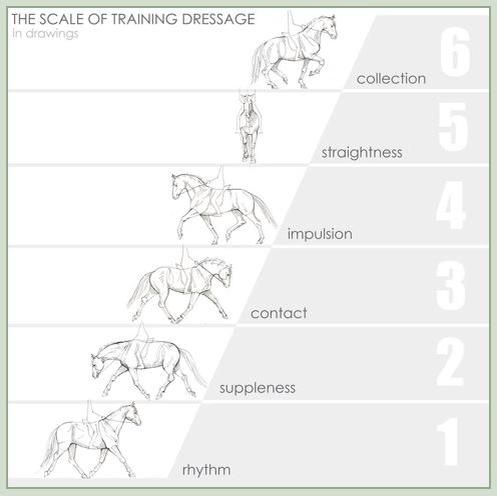The dressage training scale, or sometimes called the German training scale or pyramid, is a carefully curated process designed to help horses learn and develop their bodies in the most effective and harmonious way possible.
Each level of the pyramid builds on the next, and every goal is important towards creating a strong, balanced and comfortable horse who is capable of doing the job we’re asking of them.
While the training scale is primarily associated with ridden dressage horses, it’s applicable to any equine athlete and has been instrumental in my own journey, helping my driving horses make dramatic transformations in their musculature and movement, as well as their comfort and enjoyment of the driving activities we do together.
Here’s my favourite illustration of the pyramid, one that I saw online with a note that the artist just wanted it shared to benefit others.

My favourite thing about this particular illustration is that it gives us the visual of where we need to start in order to get to where we want to be. I bet most of us looked at that photo and wished that our driving horses looked something like the horse next to the work Impulsion. But if we try to skip the rest of the frames along the way we’ll be doing our horse a disservice, and making it much harder for them – see last week’s article on True vs False Collection for more on why shortcuts don’t help.
Building a Strong Base
At the bottom of the pyramid we have Rhythm, Relaxation and Contact. These three work together, and will improve in relation to each other as your horse builds strength and balance and understanding. While they will continually improve and need to work on these basics throughout their career, without a solid base, they can’t effectively work on the concepts at the top of the pyramid.
Rhythm means the rhythm of each gait. A consistent four beat walk and two beat trot, a steady rhythm like a metronome, no rushing or slowing, should be the goal we’re working towards.
Relaxation is the English word used on the next tier, but a more accurate translation of the German word would be “letting go” – letting go of tension, both physical and mental. Tense muscles cannot work effectively, and a tense mind will result in tense muscles.
Contact is the steady, consistent, two-way communication with your horse. Contact helps them balance and gives them confidence, it lets you tell them what to expect and helps you “hear” when they’re struggling with their rhythm or relaxation.
Advancing
Impulsion is increasing the energy in each step, and can’t truly happen without rhythm and relaxation. Straightness comes from strength and balance, a side effect of work on rhythm and relaxation and contact. And Collection is the ultimate goal of an athletic horse, when all the work and time spent has come together to allow them to use themselves to their utmost abilities.
Building Blocks
While these concepts aren’t sequential, they are building blocks you can use to help you build your driving horse into an athlete. Remembering to focus on a solid base will help us have much more success when we are ready to ask for more advanced movements. And returning to the basics anytime something doesn’t go as planned is a much better way to go than ending up in a fight with your horse over something they don’t understand or aren’t physically capable of doing.
Lifetime of Improvement
A horse trained with a focus on the classical principles of dressage, one that is brought along in a systematic manner, gradually building strength and being asked for only what they are capable of at each stage of training, is a horse who will continue to improve. Instead of peaking and then breaking down, a horse who is trained in this manner will just keep getting better and better, year after year, throughout their career. We can build them up to a long, rewarding driving career, rather than break them down with shortcuts and quick fixes.
It Won’t Take As Long As You Think
Miniature Horses build strength and fitness very quickly. With consistent, mindful, dedicated work, you will see a difference in your driving horse sooner than you think. Once again, this is a situation where going slow will actually get you there faster!
How to Get Started
If you’re wanting to learn more about these concepts and how to apply them specifically to your Miniature Driving Horse, as well as exercises and tools to help you build a personalized plan for your horse, then be sure to check out the Improving Your Miniature Driving Horse online course!

Great article